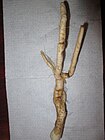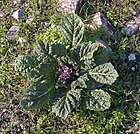Note: This is a project under development. The articles on this wiki are just being initiated and broadly incomplete. You can Help creating new pages.
Mandragora autumnalis
Mandragora autumnalis, known as mandrake or autumn mandrake, is recognized by some sources as a separate species from Mandragora officinarum, although with different circumscriptions. Others regard it as merely part of this very variable species. Plants given the name Mandragora autumnalis consist of a rosette of leaves up to 60 cm (2 ft) across, close to the ground, with a central group of usually purplish flowers followed by yellow or orange berries. The large tap-roots as well as the leaves contain alkaloids and are toxic. They have traditional uses as herbal medicines.
Uses
Parts Used
Chemical Composition
All species of Mandragora contain highly biologically active alkaloids, tropane alkaloids in particular. Jackson and Berry were unable to find any differences in the composition of these chemicals between Mandragora autumnalis and Mandragora officinarum (using the broader definition of M. autumnalis). Alkaloids present included hyoscyamine, hyoscine, cuscohygrine, apoatropine, 3-alpha-tigloyloxytropane, 3-alpha,6-beta-ditigloyloxytropane and belladonnine. Non-alkaloid constituents included sitosterol and beta-methylesculetin (scopoletin).[1]
Common names
| Language | Common name |
|---|---|
| Kannada | |
| Hindi | |
| Malayalam | |
| Tamil | |
| Telugu | |
| Marathi | NA |
| Gujarathi | NA |
| Punjabi | NA |
| Kashmiri | NA |
| Sanskrit | |
| English | Autumn Mandrake |
Properties
Reference: Dravya - Substance, Rasa - Taste, Guna - Qualities, Veerya - Potency, Vipaka - Post-digesion effect, Karma - Pharmacological activity, Prabhava - Therepeutics.
Dravya
Rasa
Guna
Veerya
Vipaka
Karma
Prabhava
Habit
Identification
Leaf
| Kind | Shape | Feature |
|---|---|---|
| Simple | Roundish | Alternate, rosette, entire, dentate or serrate |
Flower
| Type | Size | Color and composition | Stamen | More information |
|---|---|---|---|---|
| 15-30 cm | corolla, Violet | 5 | Calyx campanulate, 5-lobed, accrescent, with 5 wide triangular lobes |
Other features
List of Ayurvedic medicine in which the herb is used
Where to get the saplings
Mode of Propagation
root.
How to plant/cultivate
It likes a light, deep soil, as the roots run far down. They will do poorly in a soil that is chalky or excessively gravelly. If the soil is too wet in winter, the roots will rot. It is propagated from seeds which should be sown in deep flats or, better, singly in pots. These should be kept well-watered and when they reach a good size they should be carefully set out at least 2 feet apart. [3]
Commonly seen growing in areas
Photo Gallery
References
External Links
- Ayurvedic Herbs known to be helpful to treat Motion sickness
- Ayurvedic Herbs known to be helpful to treat Preoperative anesthetic
- Herbs with Roots used in medicine
- Herbs with common name in English
- Habit - Herbs
- Index of Plants which can be propagated by root
- Herbs that are commonly seen in the region of Garden area
- Herbs




